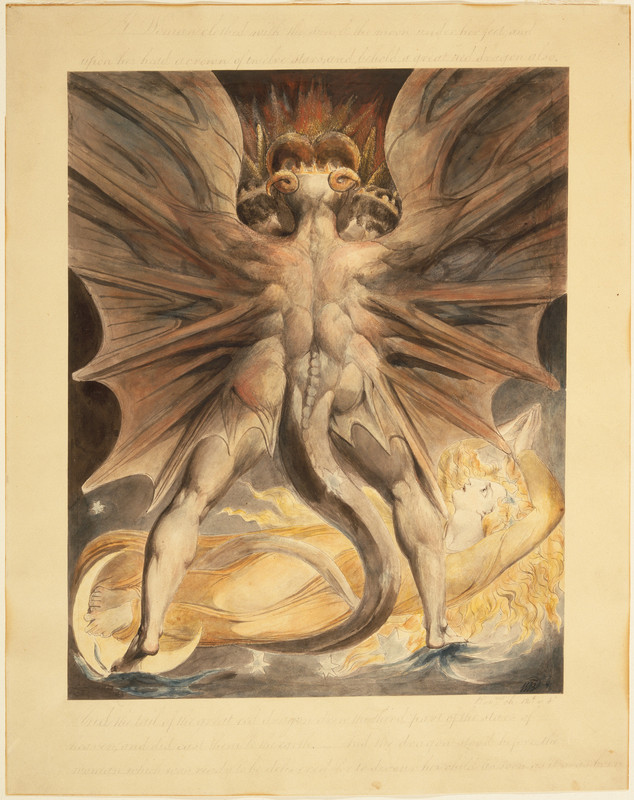Welcome to DU!
The truly grassroots left-of-center political community where regular people, not algorithms, drive the discussions and set the standards.
Join the community:
Create a free account
Support DU (and get rid of ads!):
Become a Star Member
Latest Breaking News
Editorials & Other Articles
General Discussion
The DU Lounge
All Forums
Issue Forums
Culture Forums
Alliance Forums
Region Forums
Support Forums
Help & Search
Artists
Related: About this forumWilliam Blake: The Ancient of Days: Great Art Explained
“Shall [we] call him Artist or Genius—or Mystic—or Madman? Probably he is all.”
The 18th century artist William Blake was a true radical, in the deepest sense of the world, and he raged against injustice of every kind.
Blake belonged to the Romantic age, but stands utterly alone in that age, both as an artist and as a poet: he is someone who invented his very own form of graphic art, which organically fused beautiful images with powerful poetry, while he also forged his own distinctive philosophical world-view and created an original cosmology of gods and spirits, designed to express his ideas about love, freedom, nature and the Divine.
InfoView thread info, including edit history
TrashPut this thread in your Trash Can (My DU » Trash Can)
BookmarkAdd this thread to your Bookmarks (My DU » Bookmarks)
3 replies, 412 views
ShareGet links to this post and/or share on social media
AlertAlert this post for a rule violation
PowersThere are no powers you can use on this post
EditCannot edit other people's posts
ReplyReply to this post
EditCannot edit other people's posts
Rec (7)
ReplyReply to this post
3 replies
 = new reply since forum marked as read
Highlight:
NoneDon't highlight anything
5 newestHighlight 5 most recent replies
= new reply since forum marked as read
Highlight:
NoneDon't highlight anything
5 newestHighlight 5 most recent replies
William Blake: The Ancient of Days: Great Art Explained (Original Post)
Uncle Joe
Aug 10
OP
rampartd
(246 posts)1. thanks, joe, i used ancient of days as my avatar on "discussionist. "
kids tend to like "tyger tyger" i sure do.
but this is powerful poetry
Jerusalem
And did those feet in ancient time,
Walk upon Englands mountains green:
And was the holy Lamb of God,
On Englands pleasant pastures seen!
And did the Countenance Divine,
Shine forth upon our clouded hills?
And was Jerusalem builded here,
Among these[c] dark Satanic Mills?
Bring me my Bow of burning gold:
Bring me my Arrows of desire:
Bring me my Spear: O clouds unfold:
Bring me my Chariot of fire!
I will not cease from Mental Fight,
Nor shall my Sword sleep in my hand:
Till we have built Jerusalem,
In Englands green & pleasant Land.
Beneath the poem Blake inscribed a quotation from the Bible:[10]
"Would to God that all the Lords[d] people were Prophets"
Numbers XI. Ch 29.v[9]
OldBaldy1701E
(6,220 posts)2. I am almost ashamed to say it.
But my favorite Blake piece was used in a popular novel to motivate and adorn the bad guy. The book is 'Red Dragon' by Thomas Harris and it is when we first meet Hannibal Lector. (He was not the 'bad guy' in this book.)
The piece is called 'The Great Red Dragon and the Woman Clothed with the Sun'. Here is an image of it.

It has faded over time, but I find it very powerful. (Not like Dollarhyde did, of course.)
WhiteTara
(30,139 posts)3. Recently, I have been wondering who opposed Descartes and Newton
who promoted rational thought as the truth and the way that life should be.
William Blake certainly is an anti-dote to rational mechanical thought that led to the industrial era and the deadening of the human spirit. It's interesting that he created his own cosmology.
Thank you for turning me on to this. ![]()